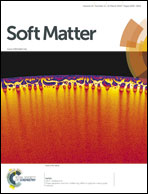2D dendritic fractal patterns from an amphiphilic polysaccharide†
Abstract
Fractals are ubiquitous in nature and they are also useful in many modern applications because they are able to incorporate multiple length scales within the same material. However, the bottom-up construction of fractals has been difficult because the physico-chemical principles that underpin the fractal formation have remained elusive. Here, an experimental model setup was used to investigate the emergence of fractals in 2D: Langmuir–Schaefer deposition of an amphiphilic polysaccharide (namely, trimethylsilyl cellulose, TMSC) on substrates with systematically varying surface free energies. Continuous monolayers of TMSC on water appeared to turn into 2D fractal patterns when deposited horizontally on a solid substrate of low surface free energy such as hydrophobically modified (methylated) silica. The decreased surface energy results in higher entropy, which enables fractal formation, as fractals have the highest degree of uncertainty of all 2D patterns. Furthermore, morphological changes within the fractals during a chemical reaction and water immersion were investigated. The results provide a starting point for a better understanding of the bottom-up construction of 2D fractal patterns from soft materials.


 Please wait while we load your content...
Please wait while we load your content...